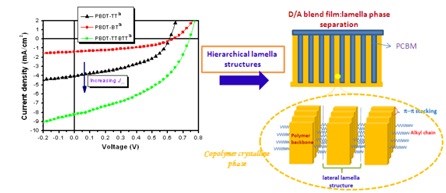Conjugated moiety effect on blend film phase separation and photovoltaic properties of benzo[1,2-b:4,5-b‘]dithiophene-containing coplanar donor–acceptor copolymers
Sol. Energy Mater. Sol. Cells 2013,108,136–145.
Yaowen Li (李耀文), Liwei Chen (陈立桅), Yujin Chen (陈玉金), Chao Li (李超), Pan Zhang (张盼), LingfengGao (高凌锋), XiaomingYang (杨晓明), Yingfeng Tu (屠迎锋)* Xiulin Zhu (朱秀林)
A series of high coplanar alternative copolymers containing benzo[1,2-b:4,5-b′]dithiophene (BDT) donor unit and alkoxy substituted electron-accepting 2,1,3-benzothiadiazole moiety (PBDT-BT), high coplanar electron-donating thieno[3,2-b]thiophene moiety (PBDT-TT), or thieno[3,2-b]thiophene attached to both sides of the benzothiadiazole moiety (PBDT-TTBTT) were designed and synthesized. The influences of the conjugated moiety on polymer optical and electrochemical properties, phase separation in blend film with (6,6)-phenyl-C61-butyric acid methyl ester (PC61BM), and photovoltaic properties for the application as donor materials in polymer photovoltaic cells (PVCs) were studied. The optical and electrochemical properties of copolymers showed that the HOMO and LUMO energy levels were determined by BDT and BT moiety in the alternative copolymers, respectively. The TT moiety does not have significant influence on the energy level when incorporated with BDT and BT units in alternative copolymers, but can significantly affect the phase separation behavior when mixed with PC61BM by improving the crystal structural order. Interestingly, hierarchical lamella structures were observed in the blend film containing copolymer and PC61BM: one is crystalline copolymer’s ordered lamella packing structure with size about 2 nm, as revealed by the XRD experiments; the other is the lamella phase separation structure with width about 15 nm. The crystal grain size in blend film was estimated by means of Scherrer’s equation, and the value coincided well with that from TEM observation. Bulk heterojunction photovoltaic devices were fabricated by using the copolymers as donors and PC61BM or (6,6)-phenyl-C71-butyric acid methyl ester (PC71BM) as acceptors. The results indicate larger crystal domain size will give better power conversion efficiency (PCE) in our system, where the domain size is smaller than the exciton diffusion length (∼20 nm). The photovoltaic device based on PBDT-TTBTT:PC71BM showed a Jsc of 9.15 mA/cm2 and a PCE of 3.54%.

链接://www.sciencedirect.com/science/article/pii/S0927024812004473